mobile View, to the German Version tap the flag


- Federal State of Brazil
- former independent Republic
• Flag
• Historical Flag
• Meaning/Origin of the Flag
• Map
• Numbers and Facts
• History
• Origin of the Country's Name
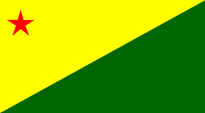
since 1903,
Flag of the federal state,
ratio = 11:20 and 7:10,
Source, by:
Flags of the World




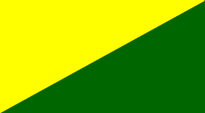
1899–1900,
National flag,
Source, by:
Flags of the World




The flag of Acre was adoped on the 14th of July in 1899 in context with the proclamation of the Republic of Acre ("1st Republic"). It is diagonally divided between yellow and green and shows since the proclamation of the "3rd Republic" on the 27th of Janaury in 1903 a five-pointed red star in the upper staff quadrant. The addition of the star was made by Placido de Castro – the leader of the rebellion of 1902 – which culminated in the proclamation of the "3rd Republic". The star should express a desired convergence to Brazil. To the meaning and the origin of the colours of the flag there are two theories:
• Yellow and green are the national colours of Brazil and should express since the proclamation of the Republic of Acre and the introduction of its flag a desired convergence to Brazil.
• Yellow stands for the mineral resources of the country and green for its forestal abundance while the red of the star stands for the people and symbolizes courage.
The flag of 1903 was confirmed again on 1st of March in 1963 as flag for the fed. state of Acre.
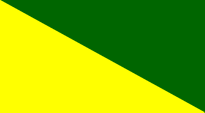
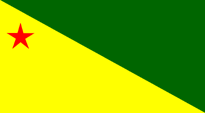
There circulate reproductions of the flag of Acre which show the diagonal partition passing from left above to right below. That this flag once had this design is very improbable because there are no documents (constitution, laws etc.) which document the decision of the State of Acre to inverse the partition later. The partition from left above to right below has its roots possibly in observations and descriptions of contemporary witnesses which saw the flag in use. About it is to comment that historical down handed descriptions of flags were done often just incidentally and desultory, and often there was no intention or as well the ability to draft a heraldical study. The history of flags in the whole world knows this problem. There is to remember the early form of the flag of the USA or the early naval flag of the USA, or the reproductions of the German black-red-golden flag etc. There is to include further that flags on the mast are to recognize hardly and to describe hardly too, descriptions of flags have to be translated(sic!) and given out correctly, and the flag has to be hoisted correctly und seen from the right side. In the concrete case of Acre exists a precise description of the coat of arms (look Flags of the World) by a contemporary witness. A fact which needs more care and excludes many sources of errors. This coat of arms showed in accordance with the description flags which show the diagonal from right below to left above, so that it is to assume with some certainty that this is the correct reproduction of the diagonal.
Source:
Flags of the World

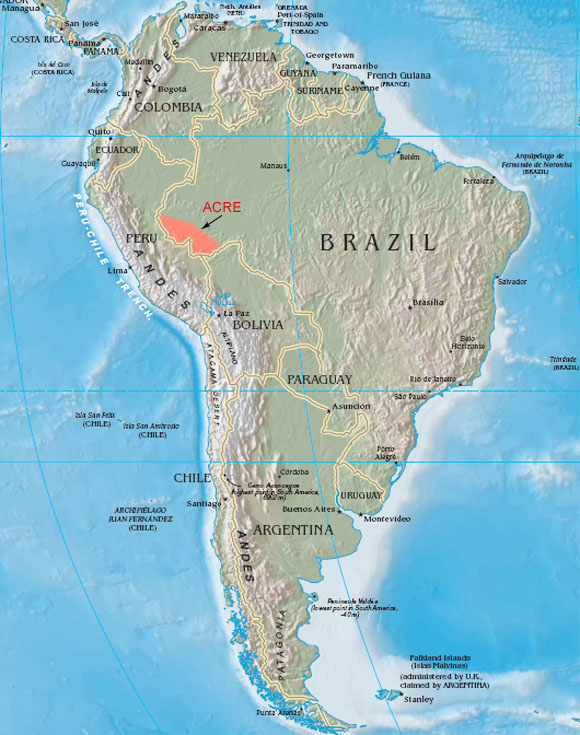
Source: Freeware, University of Texas Libraries, modyfied by: Volker Preuss

Area: 63.368 square miles
Inhabitants: 733.559 (2010)
Density of Population: 12 inh./sq.mi.
Capital: Rio Branco, 336.038 inh. (2010)
official Language: Portugese
Time Zone: GMT – 5 h
Source:
Wikipedia (D)

14th of July 1899 · foundation of the Republic of Acre ("1st Republic") by the adventurer Luis Galvez Rodriguez de Arias with support of the Brazilian federal state of Amazonas within the between Brazil, Bolivia and Peru vexed area
March 1900 · invasion of Bolivian troops, the government of Acre goes underground
17th of September 1900 · Anti-Bolivian riot
November 1900 · one more proclamation of the Republic of Acre ("2nd Republic")
25th of December 1900 · suppression of the riot and the republic by Bolivian troops
11th of July 1901 · Bolivia decides to lease Acre to US-American and British investors
6th of August 1902 · one more Anti-Bolivian riot of the people of Acre, even with assistance of the "Rubber Barons", it comes into being a regular war against Bolivia
24th of January 1903 · end of the war
27th of January 1903 · one more proclamation of the Republic of Acre ("3rd Republic")
17th of November 1903 · Treaty of Petropolis, Acre becomes divided between Brazil, Bolivia and Peru, end of the Republic of Acre
25th of Feruary 1904 · acres becomes divided into three districts and is annexed by Brazil as a federal territory
7th of April 1904 · Acre becomes a Federal Territory
15th of June 1962 · Acre becomes a state of Brazil
Source:
Wikipedia (D),
World Statesmen

The country is probably named after the River "Acre", which has its source here, and the capital Rio Branco is placed on its bank. The region of Acre was formerly part of the area of influence of the Spanish language. The Spanish word "acre" means: "biting", "sharp", "sour" or "herb". This could possibly relate to the possibly very peculiar taste of the water of the River Acre, or may possibly describe the harsh climatic conditions in the area.
Source: Volker Preuss


Kindly supported by: Wolgang Marx (D)
![]()










